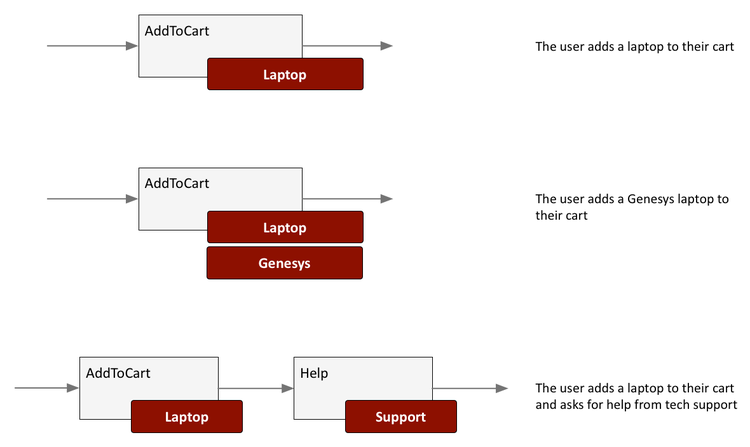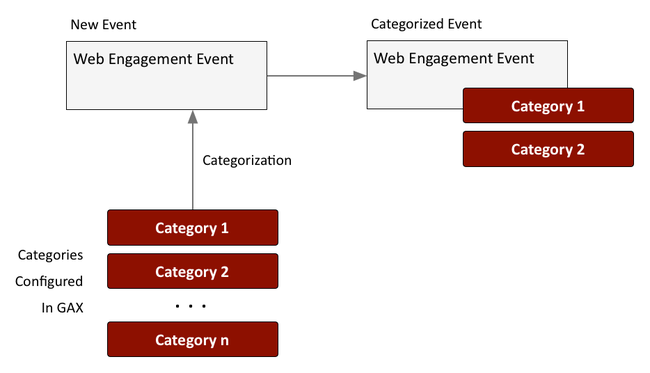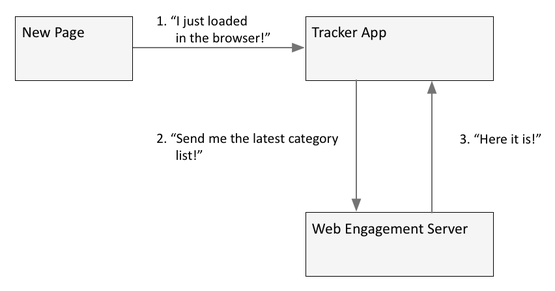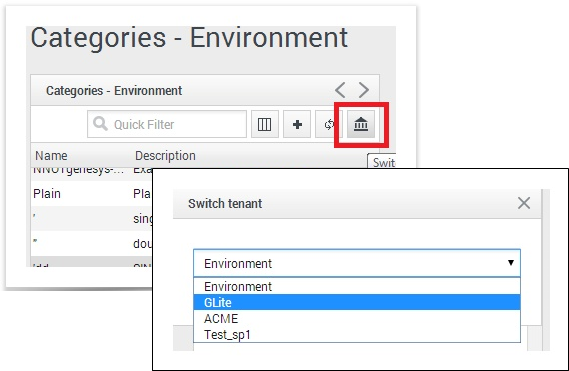Working with Categories
Contents
About Categories
When we think about things, or talk about them with our friends, we often categorize them. This can help us tell these things apart from other things that are similar to them, which means that these categories can guide us towards better decisions.
As it happens, Web Engagement needs to do some serious decision-making. Because of this, we have set up ways for you to categorize things within Web Engagement, so it can make those decisions for you as you try to help your customers in real time.
In addition to its value as a real-time analysis tool, this categorization provides a valuable way of grouping the monitoring and engagement data that goes into your reporting.
How Categories Differ from Events
You can think of a Web Engagement category as a special kind of non-hierarchical label that is assigned to an event, based on some particular characteristic of the event's data.
You can use things like the URL, the language code, the page title—or other data passed along with the event—to figure out whether that specific event fits into a particular categorization. This allows you to combine similar events into a single customer business context so you can answer questions like What happened?—which you will mainly learn from the event itself—and In what context?—which will be clarified by the categories associated with one or more events.
By combining two sets of information like this, you get an additional layer of meaning within which to bucket your events, which allows you to simplify your rules.

In the following example, we have set up categories based on the price of an item added to the user's cart. We might want to send engagement invitations to anyone who is buying the higher-priced items, while being more selective towards people with lower-end transactions.

Another big benefit of categories is that they are really easy to configure—all you have to do is open the Web Engagement GAX plugin and create the categories, and they are ready to use!
How Categories Make Events More Useful
Much of the time, the name and type of an event are enough to tell you What happened?
For example, an AddToCart event lets you know that the customer has added something to their shopping cart. But if you only rely on this, you'll have to create specific events for a lot of different actions if you want to get a good idea of what your customers are doing.
By assigning categories, you add another dimension to how you can group events, thereby cutting down on the number of events you need to set up if you want to understand your most important business criteria.
For example, in the case of an online store, an AddToCart event can be categorized by what kind of thing the customer wants to buy, such as a Phone or a TV or a Laptop, or by other important characteristics, such as the price of the item. You can also add categories that let you know when a customer is Waiting For Support, or wants to Stop Shopping.
Any and all of these categories can be a factor in triggering actions that generate a proactive engagement request—a request which could make the difference between a sale and an abandonment.

Assigning Categories to New Events
Every time the Genesys Tracker application—which is resident in the visitor's browser—generates an event, it tries to categorize it based on the category information received from the Web Engagement Server.

Workflow
Let's take a look at how these things come together when a customer is visiting your online store.
The Genesys Tracker application is constantly monitoring the pages on your website. As soon as a new page is loaded in the customer's browser—as shown in Step 1, below—the Tracker application asks for the current list of categories from Web Engagement Server (Step 2), which sends it to the Tracker (Step 3).

Here's what happens when a customer adds a laptop on an online store page, as shown in the following diagram.
Tracker is still monitoring the events associated with the new page, as shown in Step 1. When the customer adds the item to their cart, the Tracker app creates an AddToCart event (Step 2) and categorizes it by purchase category (Step 3). (Notice that the event is categorized on the browser side.)
The Tracker app then posts the categorized event to the Web Engagement Server (Step 4). At this point (Step 5), Web Engagement Server can apply its rules to all of the information that is available from the event, in order to determine whether to engage with the customer. This information can include:
- The event name and type
- The specific combination of categories that were applied to the event
- The specific combination of events and categories associated with the recent customer activity
The outcome from this activity could be a decision to provide assistance via chat, callback, or other channels (Step 6), or the server could simply decide to let the Tracker app continue monitoring.

Simple and Advanced Engagement Models
Web Engagement supports two types of events. Out of the box, you have access to several different system events, which are used in the Simple Engagement Model. You can also create your own events, known as business events, in which case you are using what we call the Advanced Engagement Model.
You can use categories with both types of event.
About the GAX Plugin
You can add and remove categories for Web Engagement through the Category interface in the Genesys Administrator Extension plugin. You create these categories during the Application Development process if you use the Simple Engagement Model when you Create Business Information.
Each category is compliant with the category definition and includes tags to define business information related to your website. To access the Categories interface, open Genesys Administrator Extension and navigate to Web Engagement > Categories.
Features
The Categories interface includes the following features:
| Feature | Usage |
|---|---|
| Create categories. | See Creating a Category for instructions. |
| Create matching tags. | See Creating Category Matching Tags for instructions. |
| Delete matching tags. | Select the tag in the Category Matching Tag section and click X. |
| Delete categories. | Select the category in the list and click Delete. The Delete Confirmation dialog opens. Click OK. |
Creating a Category
Prerequisites
- Your environment includes Genesys Administrator Extension. See Genesys environment prerequisites for compliant versions.
- You installed the Web Engagement Plugin for Genesys Administrator Extension.
Start
- In Genesys Administrator Extension, navigate to Web Engagement > Categories. The Categories interface opens.
- Click Switch Tenant, select the tenant where you deployed Genesys Web Engagement, and click OK.
- Click + to add a new Category. The New panel opens.
- Enter a Category Name. For instance, pfs-login.
- Optionally, you can enter a Category Description.
- Enable Show category in Interaction Workspace to display this category in Interaction Workspace if an agent opens interactions that are related to it.
- Click Save. The Products category is added to the list.
End
Creating Category Matching Tags
Each category should have at least one Category Matching Tag, which contains an expression to search in the URLs and titles submitted with the events of the browser. For instance, you could identify an inbound voice–related page, such as http://www.genesys.com/products/genesys-inbound-voice/overview.aspx by using plain text, such as genesys-inbound-voice, or a regular expression like 'Inbound Voice'.
Prerequisites
- You completed Creating a Category.
Start
- In Genesys Administrator Extension, navigate to Web Engagement > Categories and select a category. The <category name> panel opens.
- In the Category Matching Tags section, click +. The New panel opens.
- Fill in the form to create a tag. Consult the table below for more information about the form fields.
Field Description Name The display name for your tag. For example, Inbound Voice. Type The type of expression to search. There are three options: - Regular Expression — A regular expression search.
- Plain Text — A substring search. This is the default.
- Google Like Expression — Selecting this option opens a new window where you can enter an expression using Google search operators. When you click Generate to REGEX, it converts the expression to a regular expression and populates the Expression field.
Expression The expression to search. This can be plain text or a regular expression. Case-sensitive Selecting this field makes the regular expression case-sensitive. It is not selected by default. Language Select the language for the tag. This allows you to make the search expression specific to the localization of the browser. - Click Save. The tag is added to the list of Category Matching Tags.
- If needed, you can also define display names for the category that are language specific. In the Language-specific DisplayNames section click +. The New panel opens.
- Enter a Name.
- Select a Language.
- Click Save. The language-specific display name is added to the list on the <category name> panel.
- Click Save on the <category name> panel.
End
Regular Expressions in Tags
You can create tags that use regular expressions to search for matches by selecting "Regular Expression" from the Type list. A regular expression is a sequence of elements, either a word or expression inside quotes. Each search element can be preceded by a '-' to exclude that element. A wildcard symbol '*' can be used inside or outside of the quotes. If you prefer, you can select "Google Like Expression" for the Type, which converts anything you enter in the "Expression" field to a regular expression. If your expression is incorrect, your expression is not converted.
Search Request Patterns (Google Like Expression)
The following table describes the patterns in search requests.
| Search Options | Description |
|---|---|
| Search for all exact words in any order. search query |
The result must include all the words. These words can be substrings attached to other words—for example, [Web-search query1]. |
| Search for an exact word or phrase. "search query" |
Use quotes to search for an exact word or set of words in a specific order without normal improvements such as spelling corrections and synonyms. This option is handy when searching for song lyrics or a line from literature—for example, ["imagine all the people"]. |
| Exclude a word. -query |
Add a dash (-) before a word to exclude all results that include that word. This is especially useful for synonyms like Jaguar the car brand and jaguar the animal. For example, [jaguar speed -car]. |
| Include "fill in the blank". query *query |
Use an asterisk (*) within a query as a placeholder for any terms. Use with quotation marks to find variations of that exact phrase or to remember words in the middle of a phrase. For example, ["a * saved is a * earned"]. |




